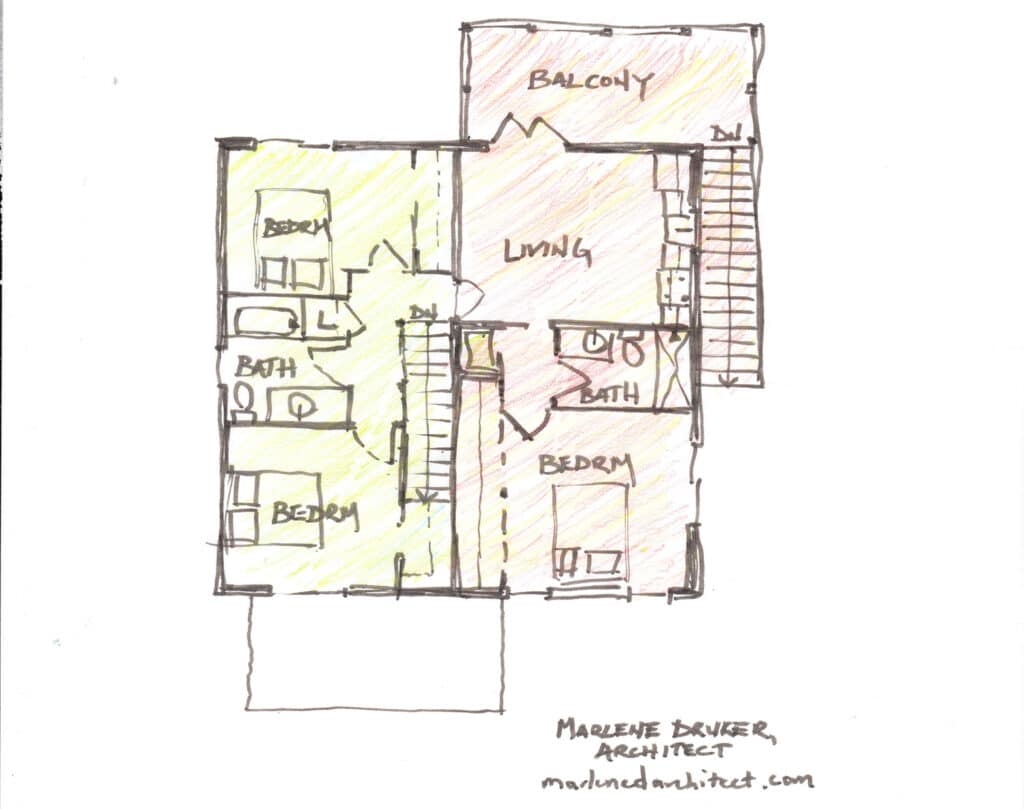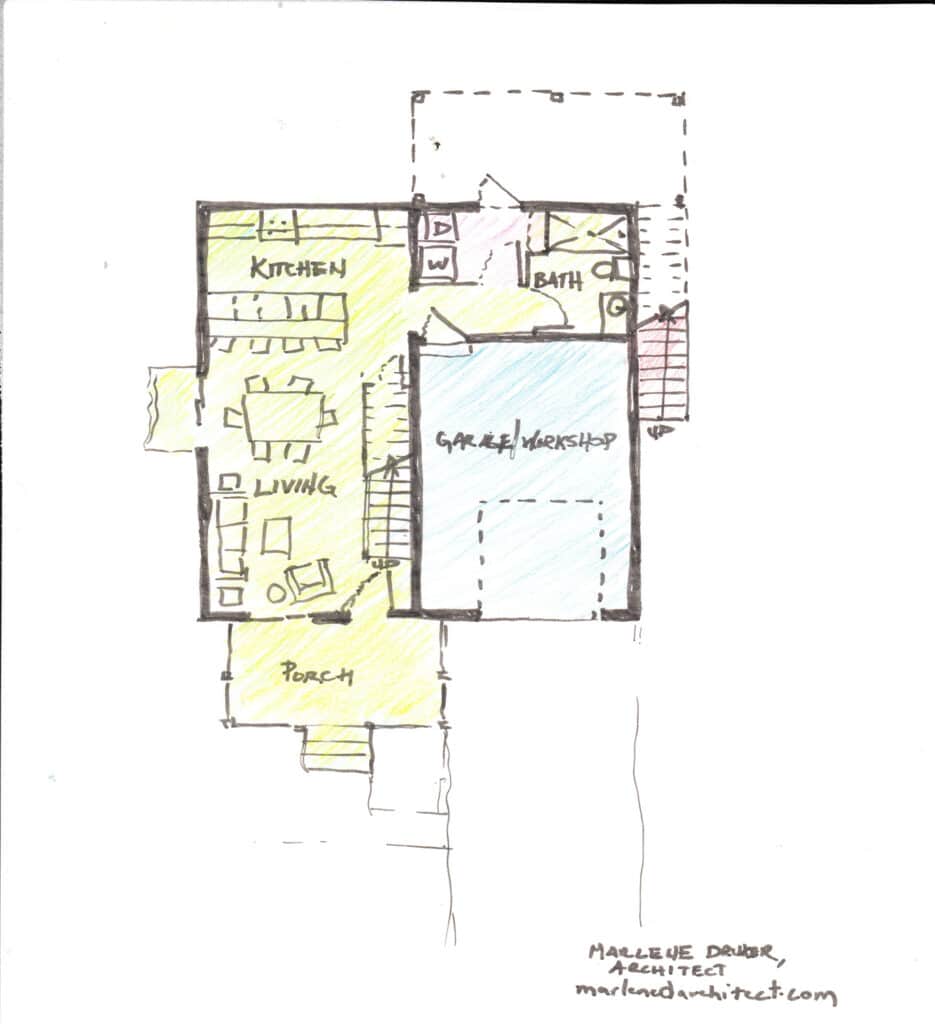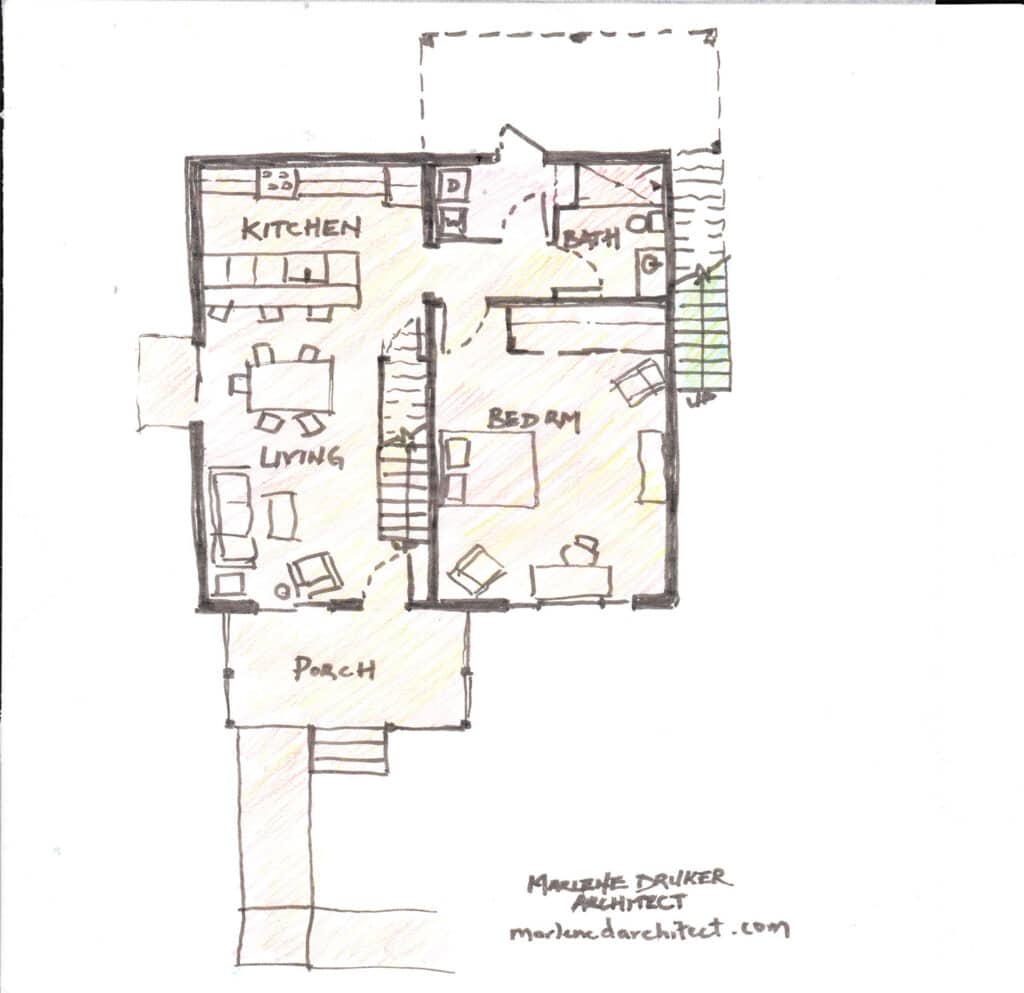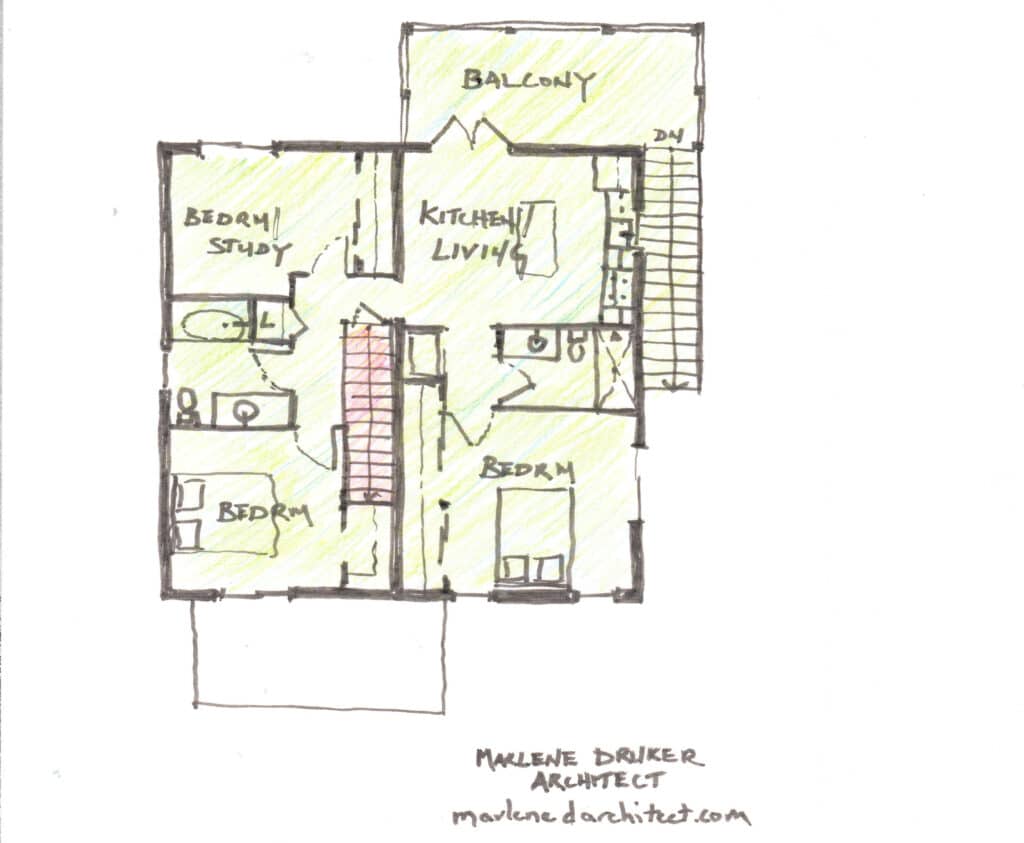Business Community Community Editorials News
Guest column: The Incredible Expanding and Shrinking House

Marlene Druker
Editor’s note: This piece was submitted by Marlene Druker, a self-employed architect based in Gig Harbor. Her home office is expansive enough to house an expensive electronic drafting board and cheap trace paper, both of which were used in imagining The Incredible Expanding and Shrinking House. This is part 1 of a 2-part series. Look for Part 2 next Monday, March 13.
When there was no way to make my partner’s former bachelor pad work for our family of four, we moved.
The youngsters are now on their way out of the family house and it is so empty that we are considering another move. What if, rather than having to move because life changed, the house could change?
I present to you THE architectural solution to this common problem:
The Incredible Expanding and Shrinking House
How does it work?
Building/life phase 1: Building, building equity
Imagine yourself a young person who has recently entered the job market and has managed to save some money. Congratulations on that and on paying your credit card bill on time every month!
You can now borrow some more money with a conventional low-interest loan for home building and build this — see phase one plans — modest two story wood framed structure, which is easily divided into two units.

The upper floor in phase 1. A homeowner could live in the portion shaded in red while renting the portion shaded in yellow to a tenant.
You could start by living in the one-bedroom, one-bathroom unit above the garage, accessed by the outdoor staircase and balcony (shown in red on the phase one upper floor plan). The rest of the structure (green) has two bedrooms and two bathrooms. You can rent that out and make your mortgage payments – and still have funds left over to have a social life!
Depending on your needs, you can make the one car garage/workshop (blue) part of the rental or use it yourself. There is space for a stackable washer dryer upstairs, but you may choose to save some money and have some extra storage space and share the laundry room (pink- accessible from door to exterior) with your tenants. If you are tight on funds while building, you could delay building out the lower level bathroom and have the rental unit be just one bathroom for the time being.

The lower floor in phase 1. Tenant and homeowner could share the laundry space. The homeowner could decide who gets custody of the garage space.
Building/life phase 2: Making room
Because you had the means to have a social life, you have met someone who you want to share your life and your space with. Congratulations again!
Maybe you like it cozy and will stay together in the smaller space in the house or maybe it is now time to move into the other part of the house and rent out the smaller space. Either way, you still have some rental income coming in while you continue to pay down the loan you took out to build the house.
Building/life phase 3: Here we grow
Kids are great. Even better when they have their own rooms.
If you haven’t already done so, sometime around the time you add a kid to the household, you will want to move into the two-bedroom space. More kids will eventually mean taking over the entire house.
The upstairs living area may be used as a home office or a playroom or converted into a fourth bedroom if needed. If you need even more space the garage can be converted into another bedroom or living or office space.
If there is room on the lot, you may want to add a carriage house type outbuilding with a garage/workshop on the lower level and maybe a space for rent or for guests or a bonus room/ office above.
Building/life phase 4: And away they go
Some days, it seems to parents that kids will never grow up. But time marches on and most of them move out, sooner or later. Now the house can shrink.
If you haven’t already converted the garage into a living space, you may now want to turn it into a bedroom and live on the lower level (red on phase four plan). The bathroom on the lower level, and in fact the entire lower level, was designed from the start to accommodate people with mobility limitations – way to think ahead! It would be easy enough to add a ramp to that porch, if needed.
The upper level (green) could be rented out separately as a two or three bedroom, two bath unit, thereby supplementing your income. Or maybe one of those kids would like to move in there, possibly with their own little kids, so that generations can be close enough to help each other, but not too close.

In phase 4, the house can be configured to accommodate people with mobility issues living on the bottom floor.
You might be able to work out an arrangement with people living upstairs where they do some work on the property or even help you inside your house in exchange for reduced rent – or you could use their rent to help you pay for home or personal care needs. If you are retired and enjoy traveling, you are not leaving your entire home empty while you away and that rental income can fund your wanderlust.
For privacy, you will probably want to block off the top of the staircase, but if planned from the start, dividing the house in this way wont take major renovations. You may also want to keep part of the upstairs for yourself and only rent out the smaller one bedroom, in which case, you would keep the door to the living space and not block off the staircase.

The upper floor can be rented to provide supplemental income for seniors.
Over its lifecycle, the house has been adapted for the people in it. With the exception of converting the garage to living space, these changes are easily reversed. When it comes time to sell the house, it will appeal to people in many phases of their lives — families who need the entire house or younger or older people who can manage with less space and would benefit from rental income.
This house is slightly smaller than average, but more people seem eager these days to do more with less – the rise in popularity of tiny homes leads me to believe that there is a real market for “not so big houses”. (Thank you to architect Sarah Susanka for coining the term and for advocating powerfully for better rather than bigger.)
Not so fast?
For dramatic purposes, I introduced The Incredible Expanding and Shrinking House as a revolutionary innovation, but of course, it is not. People have been organically making changes to their homes, often without architects (gasp!) since people have been building houses.
Many other architects have been working with similar intentions – two that I am aware of are Donald McDonald, whose work can be found in his book Democratic Architecture, and Avi Friedman, a professor at my alma matter whose “Grow Home” was built as a temporary model on the McGill University downtown campus when I was a student there and whose explorations on these topics can be found in his many published works, including one about the Grow Home.
Have I sold you yet on this modified American dream? Great – let’s get you a set of building plans!
But wait: Stay tuned for part two, which I’m calling A Dose of Reality. It will include an overview of the struggle to find appropriate building sited in our area, associated costs and other obstacles to building and living the dream. Look for it next week in Gig Harbor Now.
Marlene Druker, AIA is a self employed architect based in Gig Harbor. Her home office is expansive enough to house an expensive electronic drafting board and cheap trace paper, both of which were used in imagining The Incredible Expanding and Shrinking House.
